Zeiss Loxia 35mm f/2 Biogon T* Review

Introduction
The Zeiss Loxia 35mm f/2 Biogon T* is a new manual-aperture, manual-focus prime lens for Sony Alpha 35mm full-frame mirrorless cameras. It features an aperture range of f/2-f/22 and a ten-bladed circular diaphragm for smoother bokeh blur in out of focus areas. It features 9 elements in 6 groups, a precision-engineered full-metal casing, weighs in at 340 grams, and can be de-clicked using a supplied tool for movie making. The Zeiss Loxia 35mm f/2 Biogon T* is also able to focus as close as 30cm and it takes 52mm filters. The Zeiss Loxia 35mm f/2 Biogon T* retails for €1149 / $1299 / £979.
Ease of Use
With a maximum diameter of 62.1mm and a 66mm length, the Zeiss Loxia 35mm f/2 Biogon T*4 is a a wide-angle fixed focal length optic that's well-suited to Sony's full-frame mirrorless camera bodies. Weighing in at 340g it's also not too heavy, making this lens almost 300g lighter than Sony’s new Distagon T* FE 35mm f/1.4 ZA optic, although that lens is faster and does have auto-focusing.
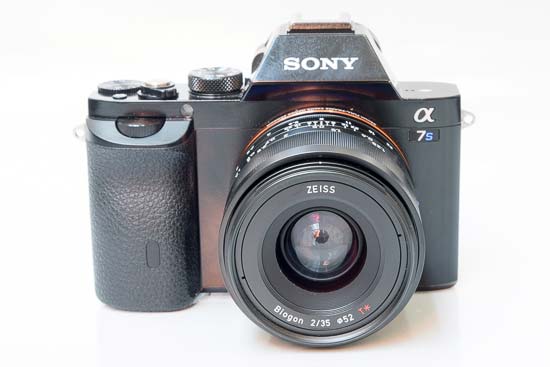 The Zeiss Loxia 35mm f/2 Biogon T* lens mounted on a Sony A7S
The Zeiss Loxia 35mm f/2 Biogon T* lens mounted on a Sony A7S
 The Zeiss Loxia 35mm f/2 Biogon T* lens mounted on a Sony A7S
The Zeiss Loxia 35mm f/2 Biogon T* lens mounted on a Sony A7S
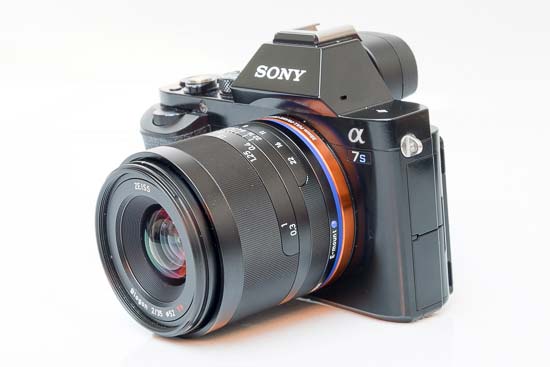 The Zeiss Loxia 35mm f/2 Biogon T* lens mounted on a Sony A7S
The Zeiss Loxia 35mm f/2 Biogon T* lens mounted on a Sony A7S
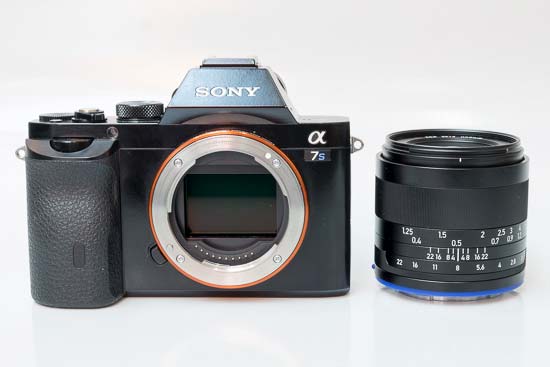 The Zeiss Loxia 35mm f/2 Biogon T* lens alongside a Sony A7S
The Zeiss Loxia 35mm f/2 Biogon T* lens alongside a Sony A7S
The Zeiss Loxia 35mm f/2 Biogon T* also boasts superb build quality. The lens’ all-metal casing is dust and moisture resistant and it features a metal E-mount bayonet. With no need for a zoom ring, the manual focussing ring spans a significant width of the lens barrel and is exceptionally smooth to operate, complete with a useful depth of field scale. Behind this is the aperture ring, with 1/3EV stops ranging from f/2 to f/22. A small adjustable screw on the bottom of the bayonet lets you select whether the aperture ring clicks into place at each aperture stop or rotates smoothly for silent operation during movie recording.
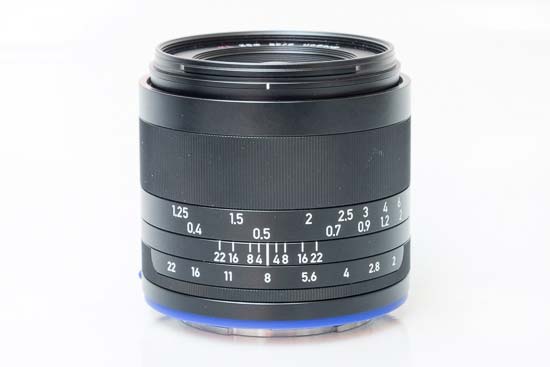 The side of the Zeiss Loxia 35mm f/2 Biogon T* lens
The side of the Zeiss Loxia 35mm f/2 Biogon T* lens
 The front of the Zeiss Loxia 35mm f/2 Biogon T* lens
The front of the Zeiss Loxia 35mm f/2 Biogon T* lens
 The rear of the Zeiss Loxia 35mm f/2 Biogon T* lens
The rear of the Zeiss Loxia 35mm f/2 Biogon T* lens
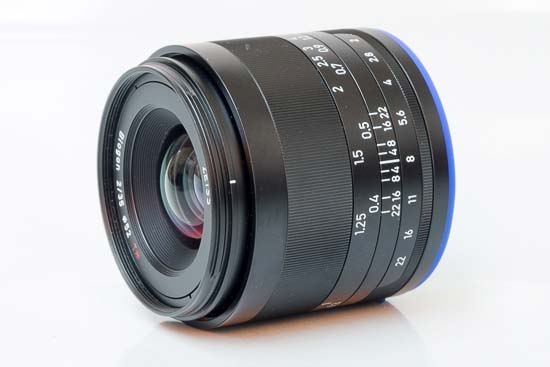 The side of the Zeiss Loxia 35mm f/2 Biogon T* lens
The side of the Zeiss Loxia 35mm f/2 Biogon T* lens
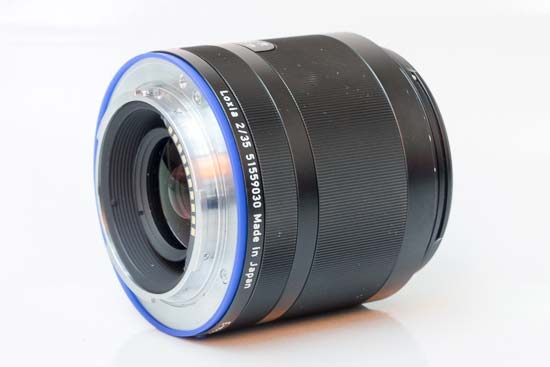 The side of the Zeiss Loxia 35mm f/2 Biogon T* lens
The side of the Zeiss Loxia 35mm f/2 Biogon T* lens
The 35mm f/1.4 has 9 lens elements in 6 groups and an almost symmetric lens design that promises better distortion, color correction and image field flatness. A ten-bladed rounded diaphragm, combined with the fast maximum aperture, helps provide smooth bokeh blur.
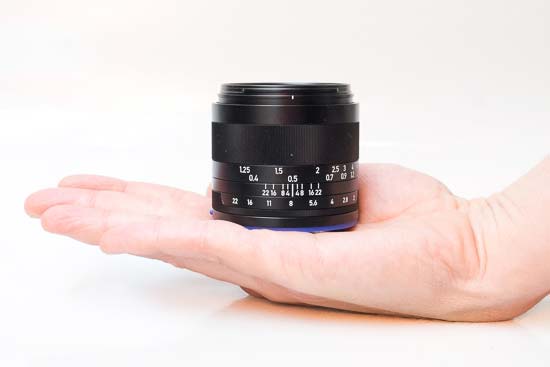 The Zeiss Loxia 35mm f/2 Biogon T* lens in-hand
The Zeiss Loxia 35mm f/2 Biogon T* lens in-hand
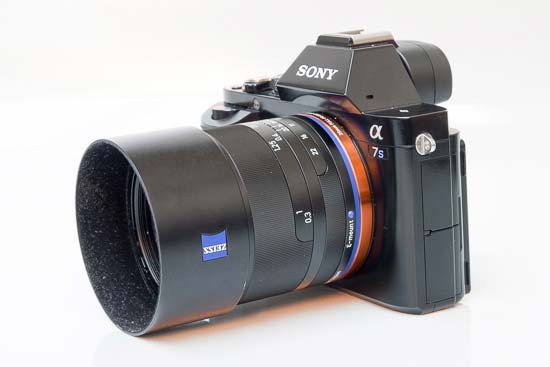 The Zeiss Loxia 35mm f/2 Biogon T* lens with the supplied lens hood fitted
The Zeiss Loxia 35mm f/2 Biogon T* lens with the supplied lens hood fitted
There’s no optical image stabilisation, but the lens’ short focal length and very fast maximum aperture alleviate the need for it. A special sealing ring on the bayonet also protects the interface between the camera and the lens. A round lens hood is supplied, although annoyingly we found that this invariably came off whenever we unmounted the lens from the camera.
Focal Range
The 35mm focal length gives an angle of view of 63 degrees on a 35mm full frame sensor.
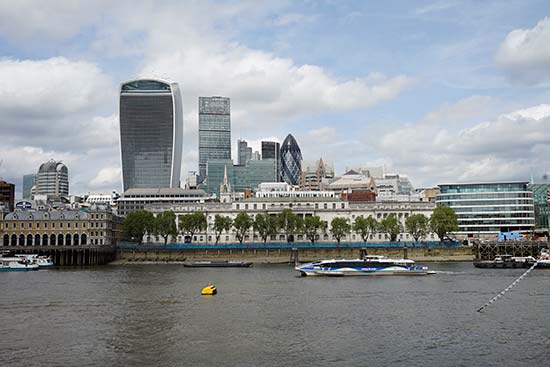 Field of view at 35mm
Field of view at 35mm
Manual Focussing
The Zeiss Loxia 35mm f/2 Biogon T*'s manual focussing ring spans a significant width of the lens barrel and is exceptionally smooth to operate, complete with a useful depth of field scale. It also has a large rotation angle which enables precise focusing and moves smoothly without any play, thus also supporting the intuitive interaction with the focal plane. The precise engravings in meters and feet, together with the depth of focus scale, help make manual focusing a veritable pleasure, especially in conjunction with the excellent Peaking feature offered by the Sony A-series cameras.
Chromatic Aberrations
Chromatic aberration (purple fringing) is rarely an issue with the Zeiss Loxia 35mm f/2 Biogon T*, so much so that we couldn't find any instances of fringing in our test shots.
Light Fall-off and Distortion
Light fall-off is noticeable wide open at f/2, though this is to be expected for such a fast lens and can easily be corrected in Photoshop. Stop down to f/2.8 and the vignetting is already less prominent, but it is still visible when shooting pale scenes that fill the frame.
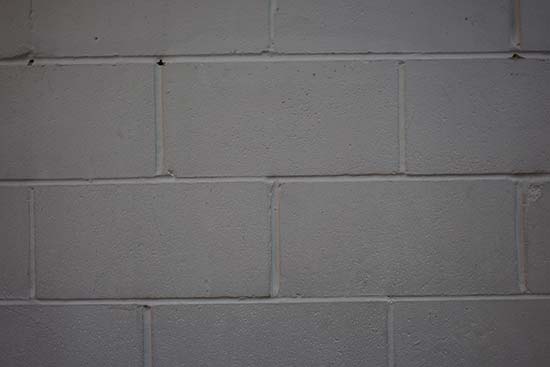 Light fall-off at 35mm
Light fall-off at 35mm
Macro
A 30cm minimum focus distance makes the lens useful for shooting reasonably close subjects. This image is uncropped and shows how close you can get to a Compact Flash card.
 Close-up performance
Close-up performance
Bokeh
A major appeal of fast, wide-aperture prime lenses is their ability to produce an eye-catching separation between a sharp subject and a very soft out-of-focus background. The Zeiss Loxia 35mm f/2 Biogon T* generates exceptionally smooth out of focus areas through its use of a ten-bladed diaphragm, which provides smoother bokeh than nine, seven or five-blade designs. Bokeh is however a fairly subjective part of a lens’ image quality, so check out these 100% crops to see the Zeiss Loxia 35mm f/2 Biogon T*’s bokeh quality for yourself.
 |
 |
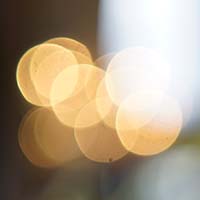 |
 |
Sharpness
In order to show you how sharp this lens is, we are providing 100% crops on the following page.
